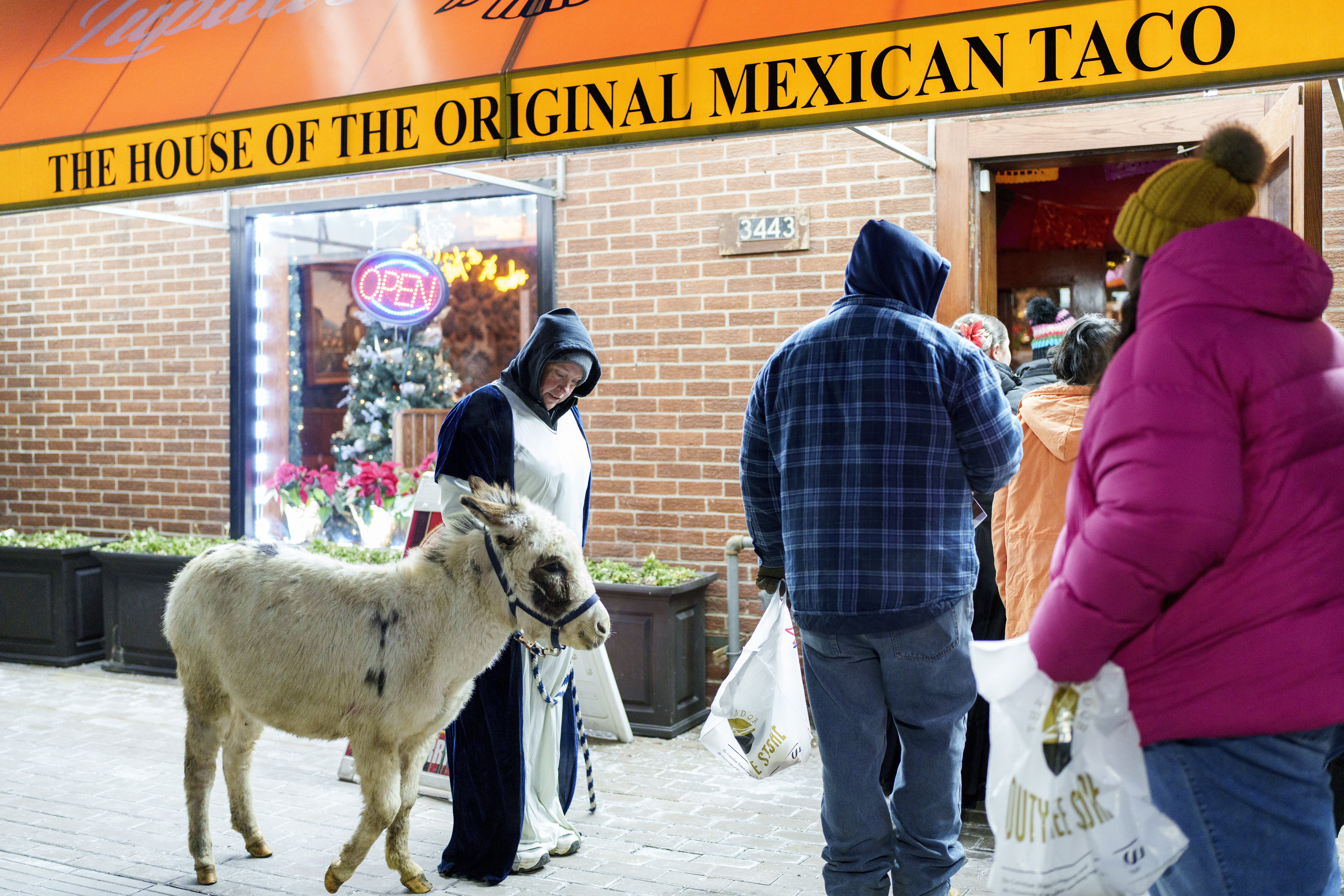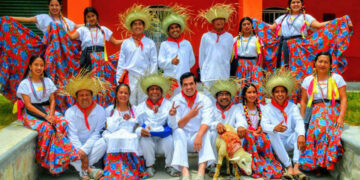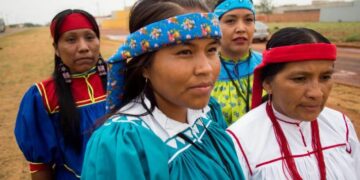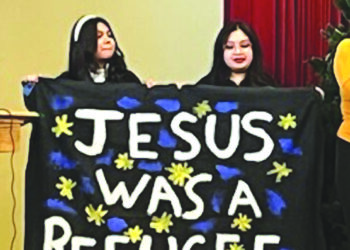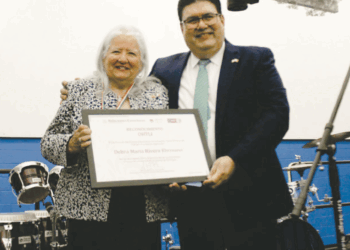Original story from hiplatina.com
Flamin’ Hot is about more than the development of the spicy snack or even the rags to riches story of its developer Richard Montañez, it’s about the collective effort behind and in front of the camera to bring a story about the Latinx community to the screen. Helmed by Eva Longoria in her feature film debut as a director, the film is both feel-good and an authentic portrayal of the struggles our community faces. Montañez (Jesse Garcia) is the brains of the film even though he doesn’t even know it at first. We see a young Richard growing up in a large Mexican American family in the 1960s in a migrant labor camp in Guasti in San Bernardino County, California in a school with white classmates who bully him. But he turns that around quickly when he gives them a taste of the burrito his mom packs him for lunch, the very food they mocked him for, and they want more so he charges them for it. And just like that, a budding entrepreneur is born.
“Taco Bell didn’t introduce the world to burritos—me and my mama did,” he says, adding, “At least, that’s what it felt like to me.” Even in adulthood though, he still finds himself amid white men and made to feel less than only to prove them wrong helping launch what would become a billion dollar business.
The story, narrated by Garcia, comes to life courtesy of screenwriters Linda Yvette Chávez (Gentefied) and Lewis Colick with Mexican American actress Annie Gonzalez as his wife, Judy, easily the heart of the film. Montañez is a high school dropout who makes a living selling drugs until he takes a job as a janitor at Frito-Lay. It’s there he finds his ambition and creativity to develop a chip that caters to the Latinx community.
“I think everyone Latinx in the industry, we are always striving to see ourselves represented in new and fresh ways. And that’s what I saw in what Eva sent to me,” Chávez tells HipLatina. “I’m Chicana I’m from LA, I ate Cheetos growing up, it’s real.”
Longoria tells us Chávez was the “only one” who could write this script sharing she was a fan of the screenwriter before Gentefied. She attributes the realness of the story to her work, in particular the cholo translations Richard provides when imagining what corporate meetings are like using cholo slang that he then interprets into typical cooperate talk. She shares that they were intentional about “humanizing” cholos and steering away from the stereotypical portrayals. At one point during Richard’s interview for the janitor job, he tries to compensate for not having a high school diploma by say he has a PhD as in he’s “poor, hungry, and determined.” It’s not just the work ethic, it’s the cholo brotherhood that comes together to support him when Flamin’ Hot Cheetos are first released. We also see Richard imparting a sense of pride in Mexican American to his own son who is once again bullied for his heritage. This level of celebration and nuanced storytelling centered on Latinx characters is a rarity making not just the story but the existence of the film itself a powerful statement.

“We’re gonna show them but in reality, they’re beautiful, family oriented, hard working, complicated. survivalists. And so that’s one thing. I think Linda really knocked out of the park was that beauty in the cholo culture,” Longoria says. The 48-year-old has been working behind the camera for more than 20 years having directed episodes of Gordita Chronicles and Jane the Virgin among others. With this film being her feature film directorial debut it’s not just a professional feat, it’s a personal one. As the daughter of Mexican American parents born in Corpus Christi, Texas with a master’s degree in Chicano Studies from California State University, Northridge, she’s well versed in the Chicano experience. Now she’s hoping Latinx audiences show up to prove to studios these stories are worth telling.
“We can’t get a film every 20 years, we’re never going to reach equality that way. So the only way that studios will make more movies like this is success and so we have to be successful. We just made this for us by us and so we did our part now we need the audience to do their part.”
When it comes to the lack of Latinx stories or diverse representation, the numbers speak for themselves in a USC Annenberg Inclusion Initiative 2021 study of films from 2019:
- Only three directors of 1,447 were Latina
- Of the top-billed Latino actors, 13.2 percent were shown as lower class/impoverished
- 39.5 percent of the top-billed Latino actors were portrayed as criminals
- 6.2 percent Latino leads/co leads occurred in 2019. In 2007, there were zero.
- Only 1.9 percent of all leads/co leads across 1,300 movies were Latinas as were only 6.5 percent of all female protagonists.
With Longoria steering the film into a place of authentic and nuanced storytelling alongside Chávez, González rounds out the Latina powerhouse trio. Her portrayal of Judy is that of the strong matriarch and the motivation he needs; Like he says in the film, “Get you a Judy.” She tells HipLatina that she was inspired by “every woman that has raised me, every woman that I know.” In the film we see Judy collecting spices to concoct what would become the basis for the Flamin’ Hot Cheeto though they also share the lab version in the film, two very different versions of the signature hot flavoring. But it’s the homestyle version that Richard and his family develop that’s the star and we see that it’s inspired by the Mexican elote that’s popular among street vendors in the LA area. That moment follows a tender scene where he tells his son, in the face of the bullying he faces at school that “being Mexican is a superpower.”
It’s lines like that that piece together the story of triumph over adversity (that includes domestic violence, lack of an education, lack of access to resources) that make the film an ode to the Latinx community. “When Linda and I sat down to come up with this, we felt the actual responsibility to deliver something authentic and good. And Annie and Jesse showed up and go, ‘Yeah, we’re with you. We’re on it’. We were all like rowing in the same direction in the boat.”
Garcia’s portrayal shows a man in the midst of figuring it out and achieving unprecedented success and the fact that it’s inspired by a true story only reinforces that these stories are out there.
Chávez says that the she and Longoria had the shared goal of wanting to “show ourselves in our full complexity and that includes the good and the bad, we’re not perfect humans. I think that’s really equality in representation where we get to be full humans and I think that’s the goal with everything that we do, we want to see our real ourselves on screen.”
Flamin’ Hot is available to stream now on Hulu and Disney+
‘Flamin’ Hot’ is Latino Excellence, Cholo Representation, & Latina Power in One
Flamin’ Hot es más que el desarrollo del bocadillo picante o incluso la historia de la pobreza a la riqueza de su desarrollador Richard Montañez, se trata del esfuerzo colectivo detrás y frente a la cámara para llevar una historia sobre la comunidad Latinx a la pantalla. Dirigida por Eva Longoria en su debut cinematográfico como directora, la película es a la vez agradable y un retrato auténtico de las luchas que enfrenta nuestra comunidad. Montañez (Jesse García) es el cerebro de la película aunque al principio ni siquiera lo sabe. Vemos a un joven Richard que crece en una gran familia mexicoamericana en la década de 1960 en un campo de trabajo para inmigrantes en Guasti en el condado de San Bernardino, California, en una escuela con compañeros blancos que lo intimidan. Pero rápidamente cambia eso cuando les da a probar el burrito que su madre le prepara para el almuerzo, la misma comida por la que se burlaron de él, y quieren más, así que les cobra por ello. Y así nace un emprendedor en ciernes.
“Taco Bell no le presentó al mundo los burritos, mi mamá y yo lo hicimos”, dice, y agrega: “Al menos, eso es lo que sentí para mí”. Sin embargo, incluso en la edad adulta, todavía se encuentra entre hombres blancos y se siente menos que solo para demostrar que están equivocados y ayudar a lanzar lo que se convertiría en un negocio de mil millones de dólares.
La historia, narrada por García, cobra vida por cortesía de los guionistas Linda Yvette Chávez (Gentefied) y Lewis Colick con la actriz mexicano-estadounidense Annie González como su esposa, Judy, fácilmente el corazón de la película. Montañez es un desertor de la escuela secundaria que se gana la vida vendiendo drogas hasta que consigue un trabajo como conserje en Frito-Lay. Es allí donde encuentra su ambición y creatividad para desarrollar un chip que se adapte a la comunidad Latinx.
“Creo que todos los Latinx en la industria, siempre nos esforzamos por vernos representados de formas nuevas y frescas. Y eso es lo que vi en lo que me mandó Eva”, cuenta Chávez a HipLatina. “Soy chicana, soy de Los Ángeles, comí Cheetos mientras crecía, es real”.
Longoria nos dice que Chávez fue el “único” que pudo escribir este guión compartiendo que era fan del guionista antes de Gentefied. Ella atribuye la realidad de la historia a su trabajo, en particular a las traducciones en cholo que ofrece Richard al imaginar cómo son las reuniones corporativas usando la jerga chola que luego interpreta en la típica charla cooperativa. Ella comparte que tenían la intención de “humanizar” a los cholos y alejarse de las representaciones estereotipadas. En un momento durante la entrevista de Richard para el trabajo de conserje, él trata de compensar por no tener un diploma de escuela secundaria diciendo que tiene un doctorado, ya que es “pobre, hambriento y decidido”. No es solo la ética de trabajo, es la hermandad chola que se une para apoyarlo cuando se lanzan por primera vez los Flamin’ Hot Cheetos. También vemos a Richard transmitiendo un sentido de orgullo por los mexicoamericanos a su propio hijo, quien una vez más es acosado por su herencia. Este nivel de celebración y narración matizada centrada en personajes latinos es una rareza, lo que hace que no solo la historia sino la existencia de la película en sí sea una declaración poderosa.

“Los vamos a mostrar, pero en realidad son hermosos, orientados a la familia, trabajadores, complicados. supervivientes Y eso es una cosa. Creo que Linda realmente dejó fuera de combate esa belleza en la cultura chola”, dice Longoria. El hombre de 48 años ha estado trabajando detrás de la cámara por más de 20 años habiendo dirigido episodios de Gordita Chronicles y Jane the Virgin entre otros. Con esta película siendo su debut como directora de largometrajes, no es solo una hazaña profesional, es una hazaña personal. Como hija de padres mexicoamericanos nacida en Corpus Christi, Texas, con una maestría en Estudios Chicanos de la Universidad Estatal de California, Northridge, está bien versada en la experiencia chicana. Ahora espera que el público latino se presente para demostrar a los estudios que vale la pena contar estas historias.
“No podemos tener una película cada 20 años, nunca vamos a alcanzar la igualdad de esa manera. Entonces, la única forma en que los estudios harán más películas como esta es el éxito y tenemos que tener éxito. Acabamos de hacer esto para nosotros y ahora hicimos nuestra parte, ahora necesitamos que la audiencia haga su parte”.
Cuando se trata de la falta de historias latinas o representación diversa, los números hablan por sí mismos en un estudio de la Iniciativa de Inclusión Annenberg 2021 de la USC de películas de 2019:
- Solo tres directoras de 1,447 eran latinas
- De los actores latinos mejor facturados, el 13,2 por ciento se mostró como de clase baja/empobrecidos
- El 39.5 por ciento de los actores latinos más cotizados fueron retratados como criminales
- 6.2 por ciento de prospectos/copromotores latinos ocurrieron en 2019. En 2007, hubo cero.
- Solo el 1,9 por ciento de todos los protagonistas/coprotagonistas de 1300 películas eran latinas, al igual que solo el 6,5 por ciento de todas las protagonistas femeninas.
Con Longoria dirigiendo la película hacia un lugar de narración auténtica y matizada junto a Chávez, González completa el trío de latinas poderosas. Su interpretación de Judy es la de la matriarca fuerte y la motivación que necesita; Como dice en la película, “Consíguete una Judy”. Ella le dice a HipLatina que se inspiró en “todas las mujeres que me criaron, cada mujer que conozco”. En la película, vemos a Judy recolectando especias para inventar lo que se convertiría en la base del Flamin’ Hot Cheeto, aunque también comparten la versión de laboratorio en la película, dos versiones muy diferentes del característico sabor picante. Pero es la versión hogareña que Richard y su familia desarrollan la que es la estrella y vemos que está inspirada en el elote mexicano que es popular entre los vendedores ambulantes en el área de Los Ángeles. Ese momento sigue a una tierna escena donde le dice a su hijo, ante el bullying que enfrenta en la escuela que “ser mexicano es un superpoder”.
Son líneas como esa las que unen la historia de triunfo sobre la adversidad (que incluye violencia doméstica, falta de educación, falta de acceso a recursos) que hacen de la película una oda a la comunidad latinx. “Cuando Linda y yo nos sentamos para idear esto, sentimos la responsabilidad real de ofrecer algo auténtico y bueno. Y Annie y Jesse aparecieron y dijeron: ‘Sí, estamos contigo’. Estamos en ello’. Todos estábamos como remando en la misma dirección en el bote”.
La interpretación de García muestra a un hombre en medio de descubrirlo y lograr un éxito sin precedentes, y el hecho de que esté inspirado en una historia real solo refuerza que estas historias existen.
Chávez dice que ella y Longoria tenían el objetivo compartido de querer “mostrarnos en toda nuestra complejidad y eso incluye lo bueno y lo malo, no somos humanos perfectos. Creo que eso es realmente igualdad en la representación donde llegamos a ser humanos completos y creo que ese es el objetivo con todo lo que hacemos, queremos vernos a nosotros mismos en la pantalla”.
Flamin’ Hot está disponible para transmitir ahora en Hulu y Disney +

